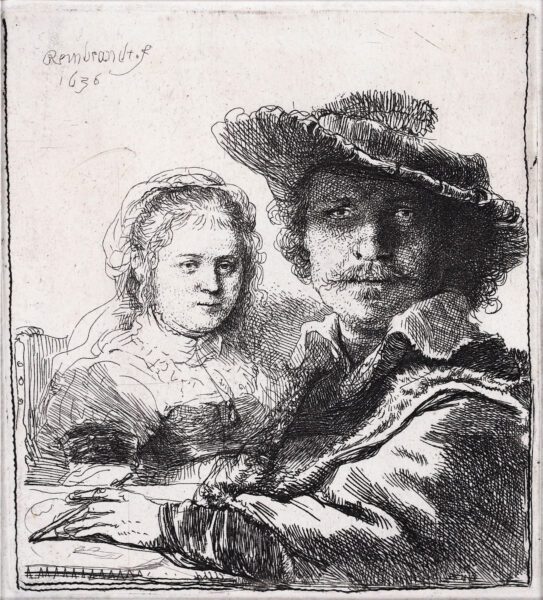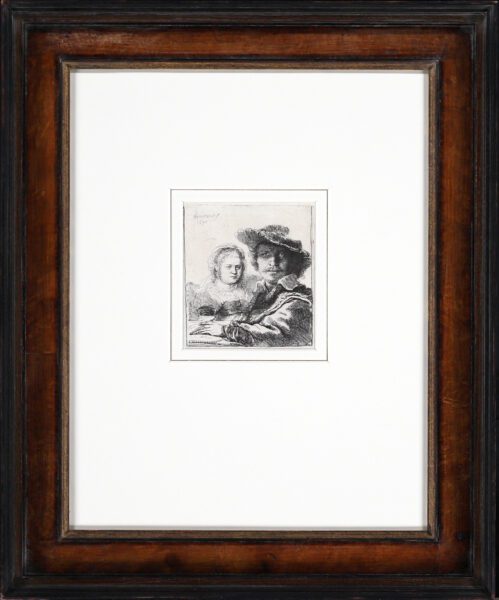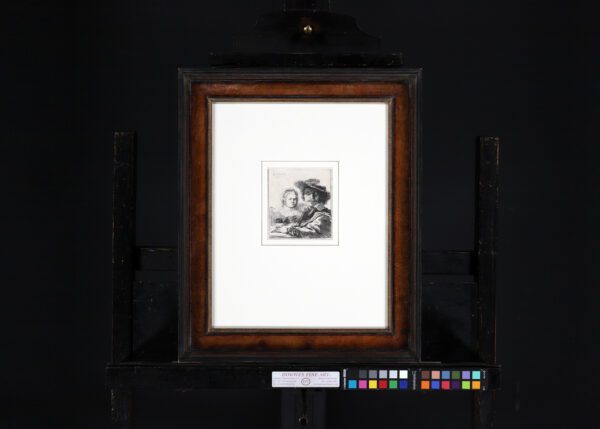“Self-portrait with Saskia”, 1636
Etching on laid paper: 10,7 x 10,0 cm
Signed and dated top left: Rembrandt.f 1636
"*" indicates required fields
Notes
During his lifetime, Rembrandt’s extraordinary skills as a printmaker were the main source of his international fame. Unlike his oil paintings, prints travelled light and were relatively cheap. For this reason, they soon became very popular with collectors not only within but also beyond the borders of the Netherlands.
Rembrandt portrays himself here with his first wife, Saskia van Uylenburgh (1612–1642).
In addition to serving as one of many self-portraits, this small etching can also be regarded as an example of a marriage portrait. Rembrandt most likely met Saskia while working for her cousin, Hendrick Uylenburgh, an art dealer who had a workshop in Amsterdam. The two married on June 22, 1634 and remained together for thirteen years until Saskia’s untimely death at the age of 30. Surprisingly, it is the only etching that Rembrandt ever made of Saskia and himself together.
The two figures are presented in half-length, seated around a table before a plain background. Rembrandt dominates the image as he engages the viewer with a serious expression. The brim of his hat casts a dark shadow over his eyes, which adds an air of mystery to his countenance. Saskia, rendered on a smaller scale and appearing rather self-absorbed, sits behind him. It’s almost as if we have interrupted the couple as they enjoy a quiet moment in their daily life.
On the one hand, as the only formal double portrait of the couple, the etching belongs to the subgenre of marriage portraiture, as Saskia bears witness to her husband’s occupation. On the other hand, the image may allude to the theme of love as the source of artistic creativity. A popular Dutch motto, “Liefde baart kunst” (“Love brings forth art”), captures this idea. That Rembrandt depicts himself as momentarily interrupted in the occupation of drawing is confirmed by his porte-crayon, a two-ended holder for his medium. Drawing, or disegno, reigned supreme in the artistic theory of the period. Since drawing was viewed as the most vivid, pristine record of what emanates from the artist’s imagination, it is hardly coincidence that Rembrandt depicted himself thus engaged.
In this 1636 etching, both he and his wife are shown wearing historical clothing. Rembrandt wears a fanciful 16th-century style plumed beret tilted at a jaunty angle and a fur-trimmed overcoat, while Saskia wears an old-fashioned veil. Such play-acting was not unusual for Rembrandt who only twice represented himself in the manner that was most popular at the time, as a contemporary Amsterdam gentleman.
Whether painting, etching or drawing, Rembrandt, who produced more self-portraits than any artist before him (roughly 75), preferred to show himself in a variety of different imagined roles.
Literature
Bartsch 19; Hind 144;
The New Hollstein Dutch 158: Second state (of IV).
Plate in existence in a private collection – with Nowell-Usticke (1967): C2
A superb, black lifetime impression of the second state (of four), with the curved slipped stroke above Saskia’s right eyebrow removed. Showing the fine horizontal wiping scratch across her shoulder and chest as well as the vertical scratch through the artist’s hand which are manifest in the first state. With narrow margins around the platemark.
Provenance
- Private collection, Germany
- Private collection, The Netherlands





